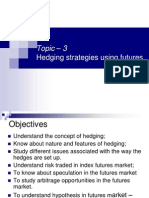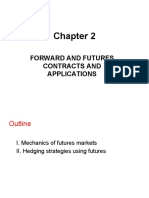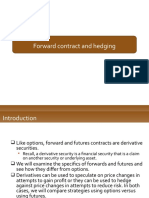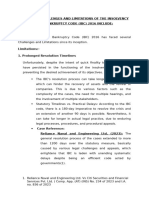0 ratings0% found this document useful (0 votes)
42 viewsPowerpoint-Slides DRM II Chapter-3
The document discusses commodity futures contracts and how they can be used to hedge risk. It explains what commodity futures are, how they work, and how taking long and short positions in the futures market can offset risks from price changes in the underlying commodities. The document also provides examples of how hedging with commodity futures contracts can protect companies from losses due to price fluctuations.
Uploaded by
ananyaakhuranaaCopyright
© © All Rights Reserved
Available Formats
Download as PDF, TXT or read online on Scribd
0 ratings0% found this document useful (0 votes)
42 viewsPowerpoint-Slides DRM II Chapter-3
The document discusses commodity futures contracts and how they can be used to hedge risk. It explains what commodity futures are, how they work, and how taking long and short positions in the futures market can offset risks from price changes in the underlying commodities. The document also provides examples of how hedging with commodity futures contracts can protect companies from losses due to price fluctuations.
Uploaded by
ananyaakhuranaaCopyright
© © All Rights Reserved
Available Formats
Download as PDF, TXT or read online on Scribd
You are on page 1/ 25
CHAPTER 3
Derivatives and Risk Management
By Rajiv Srivastava
(c) Oxford University Press, 2014. All rights reserved.
Commodity futures have commodities as underlying
assets.
Futures on commodities help mitigate price risk.
Trading in forward and futures on commodities is not
new. It has been in vogue for more than 100 years.
Due to possibility of speculation with futures, the
commodities futures is often regarded as unwarranted
product and as a disservice to society.
(c) Oxford University Press, 2014. All rights reserved.
Futures contracts on commodities enable
Price discovery,
Smoothing of seasonal price variations,
Efficient dissemination of information,
Reduction in cost of credit, and
Increased efficiency of physical markets.
(c) Oxford University Press, 2014. All rights reserved.
The usual tools of containing the volatility in the
commodity prices like buffer stocks, controlled and
phased release of commodities, minimum support
price etc have either failed or have proved too
expensive for the economy.
Commodity futures trading in developing country can
contribute a lot to the stability of fiscal management,
increasing the effectiveness of price protection at
national level and improving the efficiency of
developmental programmes.
(c) Oxford University Press, 2014. All rights reserved.
Stability to Government’s Revenue
Government budget, developmental expenditure, and balance
of payment are crucially dependent upon prices of
commodities. Volatility in commodity prices causes volatility in
budgetary provisions and government’s developmental
expenditure. Therefore at national level there is a need to reduce
the volatility.
Eliminating Minimum Support Price and Subsidy
Commodity futures trading helps smoothen the variability in
government’s revenue and transfers the price risk management
from government regulation to private participants.
(c) Oxford University Press, 2014. All rights reserved.
Futures contracts on commodities differ significantly from those
on financial assets in terms of quality specifications and delivery
mechanism.
The consumption value of commodity makes valuation of futures
difficult.
Different qualities of commodities has pricing and delivery problems.
Commodity futures are governed by seasons and perishable nature of
the underlying assets.
Supply of commodities (the agricultural products) is confined to the
harvesting period while the consumption is uniform throughout the
year.
(c) Oxford University Press, 2014. All rights reserved.
The pricing of futures contracts commodities cannot
use “no arbitrage argument” due to convenience yield
attached with commodities.
Due to consumption value of the asset the reverse cash and
carry arbitrage implying shorting the asset and buying futures
may not be executable.
Therefore, we only have an upper bound to the futures price
F ≤ (S0 + s) erT
Therefore commodity futures may remain underpriced.
(c) Oxford University Press, 2014. All rights reserved.
Spot price of cardamom = Rs 714 per kg.
Financing cost = 10% per annum with continuous compounding
What should be the price of the 3-m futures contract on cardamom?
If warehousing and insurance cost are placed at 1% what would be the
fair value of the 3-m futures contract?
Solution
The fair value of futures contract is given only as upper bound
F1 ≤ S0 x ert , F1 ≤ 714 x e0.10 x 3/12 = Rs 732.07 per kg
Warehousing and insurance cost would be added to the financing
cost for determining the upper bound of fair value of the futures
F1 ≤ S0 x ert ,
F1 ≤ 714 x e0.11 x 3/12 = Rs 733.91 per kg
(c) Oxford University Press, 2014. All rights reserved.
Long and Short Positions
Hedging Principle
Short Hedge
Long Hedge
(c) Oxford University Press, 2014. All rights reserved.
Long and Short Positions
When one holds the underlying asset he is said to be long on
the asset. For example a jeweller holding gold or silver is long on
the asset.
The one who requires the asset in future is said to be short. For
example a tea exporter needing stock of tea to execute the
pending orders is short on tea.
Similarly in the futures market
If one buys a futures contract he is said to be long, and
If one sells the futures contract he is said to be short.
(c) Oxford University Press, 2014. All rights reserved.
To execute a hedge following steps are taken:
One who is long on the asset, goes short on the futures
market, and the one who is short on underlying goes long in
the futures market.
At an appropriate time one can neutralize the position in the
futures market, i.e. go long on futures if one was originally
short and go short on futures if one was originally long, and
receive/pay the difference of prices.
Sell or buy the underlying asset in the physical market at
prevailing price.
(c) Oxford University Press, 2014. All rights reserved.
When one has long position in the asset he needs to
take a short position in futures to hedge. It is referred as
short hedge.
For example, a sugar mill would go short on the futures
contract on sugar to hedge against the fall in price.
If prices fall the short position in futures would yield
profit compensating for the loss due to reduced
realized value of sugar in the spot market.
(c) Oxford University Press, 2014. All rights reserved.
Consider a sugar mill. It is expected to produce 100 MT of sugar in
the month of April. The current price today (the month of
February) is Rs 22 per Kg. April futures contract in sugar due on
20th April is trading at Rs 25 per Kg. The sugar mill apprehends that
the price lesser than Rs 25 per Kg will prevail in April due to
excessive supply then.
How can the sugar mill hedge its position against the anticipated
decline in sugar prices in April?
To execute the hedging strategy the sugar mill takes opposite position in
the futures market.
The sugar mill is long on the asset in April. Therefore it needs to sell the
futures contract today.
(c) Oxford University Press, 2014. All rights reserved.
If price falls to Rs 22 per Kg. Cash flow (Rs per Kg.)
Sold futures contract in February + 25.00
Bought futures contract in April - 22.00
Gain in the futures market + 3.00
Price realized in the spot market +22.00
Effective price realized Rs 25.00 per Kg.
Here the loss of Rs 3 (Rs 25 – Rs 22) in the spot market is made up
by an equal gain in the futures market.
(c) Oxford University Press, 2014. All rights reserved.
If price rises to Rs 26 per Kg. Cash flow (Rs/Kg.)
Sold futures contract in February + 25.00
Bought futures contract in April - 26.00
Loss in the futures market - 1.00
Price realized in the spot market +26.00
Effective price realized Rs 25.00 per Kg.
Here the gain of Rs 1 (Rs 26 – Rs 25) in the spot market is offset by
the equal loss in the futures market.
(c) Oxford University Press, 2014. All rights reserved.
When one has short position in the asset he needs to
take a long position in futures to hedge. It is referred as
long hedge.
For example, an importer of oil would go long on the
futures contract on oil to hedge against the rise in
price.
If prices indeed rise the long position in futures would
yield profit compensating for the loss due to increased
price of oil in the spot market.
(c) Oxford University Press, 2014. All rights reserved.
A perfect hedge is one where loss on the physical
position is exactly offset by gain in the financial position
and vice-versa.
The Perfect Hedge
Short on underlying
Gain Long on Futures
Gain in
physical market
Price
Loss in
futures market
Loss
(c) Oxford University Press, 2014. All rights reserved.
Except by coincidence futures hedge is imperfect. The
gains/losses in the futures do not exactly offset the
loss/gains in the physical position because:
the exposure in the underlying and futures market may not
be on the identical asset of same quality,
the value of exposure in the underlying and the futures may
not be same because futures contract have fixed size.
the time of maturity of the futures contract may not be
same as the time of exposure in the physical position
because maturities of futures contract are specific.
(c) Oxford University Press, 2014. All rights reserved.
Basis is difference of futures price, F and spot price, S. It
declines as time to maturity approaches.
Basis at the beginning is B0 = F0 – S0
Basis at the end is B1 = F1 – S1
With futures hedge we have opposite positions in
physical and futures markets.
Gain/loss in the spot market = S1 – S0
Gain/loss in the futures market = F0 – F1
(c) Oxford University Press, 2014. All rights reserved.
In a hedged portfolio consisting of long/short position
in the spot and short/long position in futures we have
net gain/loss on the portfolio
= S1 – S0 + F0 – F1 = (F0 – S0) – (F1 – S1)
= B 0 – B1
The risk in the hedged portfolio would be equal to the
difference of basis at start and end of hedge.
Hedging with futures is not perfect. Price risk gets
replaced by much smaller basis risk.
(c) Oxford University Press, 2014. All rights reserved.
Hedge ratio is the number of futures contract to have
minimum risk. It depends upon the risks in the spot
prices, futures prices and the co-efficient of correlation
between the two.
σs
h* = ρ
σf
Where h* = Optimum Hedge Ratio
ρ = Correlation coefficient of spot and futures price
σs, σf = Standard deviations of spot & futures prices respectively
(c) Oxford University Press, 2014. All rights reserved.
Futures can also be used for hedging against the
quantity uncertainties as price and quantity have
inverse relationship.
Hedge ratio for quantity hedging depends upon the
ratio of covariance of revenue and variance of price.
Covariance of revenue with price
Quantity for hedging =
Variance of price
(c) Oxford University Press, 2014. All rights reserved.
Futures can be used for speculation if the estimate of
future spot price is different than the futures price.
To speculate on the prices of commodities one has to
do one of the following:
If a trader expects a price fall he simply has to sell a futures
contract today and buy it later;
If a trader anticipates a rise in prices he simply has to buy the
futures today and sell later;
(c) Oxford University Press, 2014. All rights reserved.
Spread strategies in futures are concerned with the
mispricing of futures contracts
a) in two different assets called
Inter-commodity spread
b) in two different markets called
Inter-market spread
c) of two different maturities called
Calendar spread
(c) Oxford University Press, 2014. All rights reserved.
Spread strategies can be used for protecting gross
profit margin where futures are available on inputs and
outputs. For example sugarcane and sugar.
Variations in gross profit margin can be minimized
By going long on futures of raw material we can have
assured raw material price and hence the cost.
By going short on futures on finished goods items we can
have assured prices for finished goods.
With revenue and cost hedged the gross profit margin can
be protected or made more stable.
(c) Oxford University Press, 2014. All rights reserved.
You might also like
- Unit Trust Investment Holding Statement As at 26/04/2021: Penyata Pegangan Pelaburan Unit Amanah SetakatNo ratings yetUnit Trust Investment Holding Statement As at 26/04/2021: Penyata Pegangan Pelaburan Unit Amanah Setakat1 page
- Seniors 2013: Belen High School & Infinity High SchoolNo ratings yetSeniors 2013: Belen High School & Infinity High School16 pages
- SWOT Analysis of Dutch Bangla Bank Limited On Basis of Financial Performance83% (6)SWOT Analysis of Dutch Bangla Bank Limited On Basis of Financial Performance57 pages
- Chapter 2 - Forward and Futures and Applications - 2022 - S100% (1)Chapter 2 - Forward and Futures and Applications - 2022 - S66 pages
- OFD Session - 4 Hedging With Futures Contracts - Com Futures - StudentsNo ratings yetOFD Session - 4 Hedging With Futures Contracts - Com Futures - Students26 pages
- FIN4003 - Lecture05 - Hedging - Strategies - Using - Futures 20 Sep 2018No ratings yetFIN4003 - Lecture05 - Hedging - Strategies - Using - Futures 20 Sep 201838 pages
- Lecture 2 - Derivative Market: Futures Forwards OptionsNo ratings yetLecture 2 - Derivative Market: Futures Forwards Options39 pages
- Chapter 3-Hedging Strategies Using Futures-29.01.2014No ratings yetChapter 3-Hedging Strategies Using Futures-29.01.201426 pages
- Lecture 2 - Derivative Market: Futures Forwards OptionsNo ratings yetLecture 2 - Derivative Market: Futures Forwards Options39 pages
- Chapter 3 (Hedging Strategies Using Futures)No ratings yetChapter 3 (Hedging Strategies Using Futures)20 pages
- 4 - Hedging Strategies Using Futures PDFNo ratings yet4 - Hedging Strategies Using Futures PDF74 pages
- Lec02 - Futures Market and Hedging StrategiesNo ratings yetLec02 - Futures Market and Hedging Strategies38 pages
- Chapter 4: Hedging Strategies Using FuturesNo ratings yetChapter 4: Hedging Strategies Using Futures10 pages
- DERVFOP - Lecture 3 (Hedging Strategies Using Futures)No ratings yetDERVFOP - Lecture 3 (Hedging Strategies Using Futures)29 pages
- Chapter 3: Hedging Strategies Using FuturesNo ratings yetChapter 3: Hedging Strategies Using Futures14 pages
- Hedging Strategies Using Futures- from netNo ratings yetHedging Strategies Using Futures- from net27 pages
- Risk Management Using Futures ContractsNo ratings yetRisk Management Using Futures Contracts17 pages
- Hedging Strategies Using Futures and OptionsNo ratings yetHedging Strategies Using Futures and Options5 pages
- Appendix C: Interest and Annuity Tables For Discrete CompoundingNo ratings yetAppendix C: Interest and Annuity Tables For Discrete Compounding19 pages
- Accounting Terminology Guide - Over 1,000 Accounting and Finance Terms100% (1)Accounting Terminology Guide - Over 1,000 Accounting and Finance Terms50 pages
- United States Bankruptcy Court Southern District of Florida Voluntary Petition100% (1)United States Bankruptcy Court Southern District of Florida Voluntary Petition55 pages
- Passion Reborn": Internship Report On Bank of Punjab100% (1)Passion Reborn": Internship Report On Bank of Punjab99 pages
- The Major Challenges and Limitations of The Insolvency and Bankruptcy CodeNo ratings yetThe Major Challenges and Limitations of The Insolvency and Bankruptcy Code19 pages
- Glass - B2 - PGDM10 - Strategy - Industry Analysis ReportNo ratings yetGlass - B2 - PGDM10 - Strategy - Industry Analysis Report12 pages
- Project ON Investment Options in India: Sakshi Singhal Year Section - A ROLL - NO. - 3001100% (1)Project ON Investment Options in India: Sakshi Singhal Year Section - A ROLL - NO. - 300134 pages
- Financial Accounting II - MGT401 Spring 2012 Mid Term Solved Quiz0% (1)Financial Accounting II - MGT401 Spring 2012 Mid Term Solved Quiz21 pages
- Unit Trust Investment Holding Statement As at 26/04/2021: Penyata Pegangan Pelaburan Unit Amanah SetakatUnit Trust Investment Holding Statement As at 26/04/2021: Penyata Pegangan Pelaburan Unit Amanah Setakat
- A level Economics Revision: Cheeky Revision ShortcutsFrom EverandA level Economics Revision: Cheeky Revision Shortcuts
- Seniors 2013: Belen High School & Infinity High SchoolSeniors 2013: Belen High School & Infinity High School
- SWOT Analysis of Dutch Bangla Bank Limited On Basis of Financial PerformanceSWOT Analysis of Dutch Bangla Bank Limited On Basis of Financial Performance
- Chapter 2 - Forward and Futures and Applications - 2022 - SChapter 2 - Forward and Futures and Applications - 2022 - S
- OFD Session - 4 Hedging With Futures Contracts - Com Futures - StudentsOFD Session - 4 Hedging With Futures Contracts - Com Futures - Students
- FIN4003 - Lecture05 - Hedging - Strategies - Using - Futures 20 Sep 2018FIN4003 - Lecture05 - Hedging - Strategies - Using - Futures 20 Sep 2018
- Lecture 2 - Derivative Market: Futures Forwards OptionsLecture 2 - Derivative Market: Futures Forwards Options
- Chapter 3-Hedging Strategies Using Futures-29.01.2014Chapter 3-Hedging Strategies Using Futures-29.01.2014
- Lecture 2 - Derivative Market: Futures Forwards OptionsLecture 2 - Derivative Market: Futures Forwards Options
- DERVFOP - Lecture 3 (Hedging Strategies Using Futures)DERVFOP - Lecture 3 (Hedging Strategies Using Futures)
- Appendix C: Interest and Annuity Tables For Discrete CompoundingAppendix C: Interest and Annuity Tables For Discrete Compounding
- Accounting Terminology Guide - Over 1,000 Accounting and Finance TermsAccounting Terminology Guide - Over 1,000 Accounting and Finance Terms
- United States Bankruptcy Court Southern District of Florida Voluntary PetitionUnited States Bankruptcy Court Southern District of Florida Voluntary Petition
- Passion Reborn": Internship Report On Bank of PunjabPassion Reborn": Internship Report On Bank of Punjab
- The Major Challenges and Limitations of The Insolvency and Bankruptcy CodeThe Major Challenges and Limitations of The Insolvency and Bankruptcy Code
- Glass - B2 - PGDM10 - Strategy - Industry Analysis ReportGlass - B2 - PGDM10 - Strategy - Industry Analysis Report
- Project ON Investment Options in India: Sakshi Singhal Year Section - A ROLL - NO. - 3001Project ON Investment Options in India: Sakshi Singhal Year Section - A ROLL - NO. - 3001
- Financial Accounting II - MGT401 Spring 2012 Mid Term Solved QuizFinancial Accounting II - MGT401 Spring 2012 Mid Term Solved Quiz

























































































